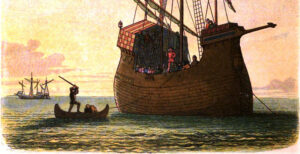May 1st & 2nd
The Duke of Suffolk’s Demise
You’ll have to forgive this diary entry as it covers two days – but as it’s all the same subject I thought it prudent to merge the two days together, so the narration flows better.
May 1st
Having set off the day before from Ipswich Harbour, William set sail with a small flotilla of boats of 3 or 4 boats, ready for his first day of banishment. With papers of safety from both the King and Philip the Good he stopped his flotilla somewhere near Dover.
Ships Intercepted
William sent one ship in his flotilla, to Calais, to ascertain how he would be received, should he put to port there. This boat was intercepted by a ship called the Nicholas of the Tower and others. Whether this interception was by design or not the information of where the Duke of Suffolk was waiting was known and headed towards him.
Whatever the size of the boat that William was on, the Nicholas of the Tower was much bigger, so when William was invited to step onboard, he wasn’t in a position to turn the offer down. How William was to be received was soon revealed when he was greeted with “Welcome Traitor”.
A story comes from this greeting which is highly likely a made up one, when William asked what the names of the ship was. When he was told it was Nicholas of the Tower, he was very concerned as he was warned by an astrologer that he would only survive if he escaped the tower. He had assumed the astrologer meant the Tower of London.
One historian report’s that the safe passage papers were then ripped up in front of him, to show that they meant nothing.
Mock Trial
The ship then held a trial, no doubt a rerun of the case that was put before the king previously with the added possibility of some personal grievances too. No knowledge of the trial have been passed down and recorded, but my view is that William would have probably refused to recognise the court in which he stood (like Charles I), but that is just a guess. William was found to be guilty of the charges and sentenced to death. He was given until the next morning to prepare for his execution.
May 2nd
After being shriven by his chaplain, William was put into a small rowing boat and prepared for execution. Here I have some issues of the accounts of the execution which does not ring true.
Execution
Some historians say that he was asked to lay down with his head on a block and an axe was used, others say a rusty sword was used, and others say the gunwale was used. What they all agree on was it was a botched execution (perhaps by design) and it took half a dozen chops to complete the deed. The use of a gunwale (side of boat) would end up with the head falling in the sea and perhaps losing the macabre trophy (admittedly, I am not aware of the buoyancy of heads in sea water). Also, the size of boat in which to do the execution on – vigorous activity in a rowing boat upon even a calm sea must be precarious, especially if you have to chop 6 times. Normally the arms would have to be held (so two more people standing up in the boat) or tied down to stop the badly mangled execution victim, reacting to failed attempts.
Was William so stoic he just kept very still and accepted his fate? I suspect not and doubt this part of the story. He either was executed on the Nicholas of the Tower or, more likely in my opinion, executed when he reached the shoreline. After a deviation I will now return to the narration of the story.
The body was then thrown on the beach near Dover and some say the head was placed upon a pole. His body was stripped of its valuable clothing. William’s retinue, who were travelling with him, were also robbed but put ashore unharmed with their now dead master.
Who could have masterminded such an audacious crime? One historian suggested that Henry Holland may have been involved, but that was unlikely due to his age and Roger Virgoe agrees with me, but his ideas are far more informed than mine. See Death of William De La Pole (a pdf).
Who was responsible?
Roger Virgoe points out that the Nicholas of the Tower was on privateering duties in the channel in the preceding years, attacking anything French (not exclusively) and may have been acting independently. Some of the ship hands may have also been involved in the execution of Adam Moleyns in January. I suspect there was some political guidance behind this due to the mock trial. If this was independent, I suspect they would get in, kill him and get out again, before another ship came nosing about to see what was happening.
The news of Williams execution got to London and Queen Margaret in two days, but it took 4 days for the news to get to Leicester, where the King was holding parliament.
Williams body was taken to St Martins Priory, Dover. After 3 days the Sheriff of Kent sent his under sheriffs to judges in order to find out what to do next. The king eventually ordered that Williams body was to be taken to Wingfield, for burial.
